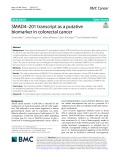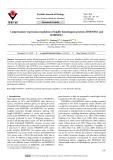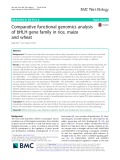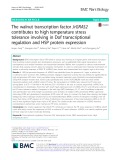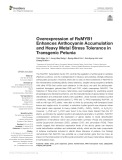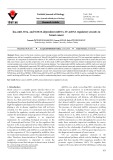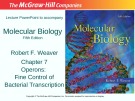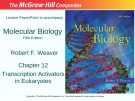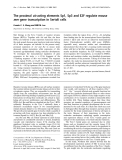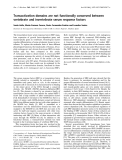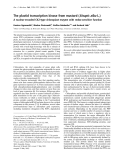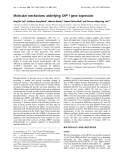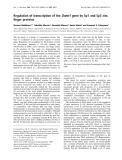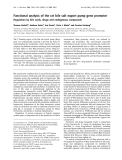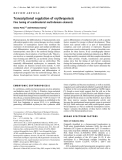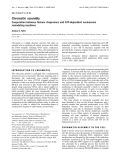
Transcriptional regulation
-
Transcripts with alternative 5′-untranslated regions (UTRs) result from the activity of alternative promoters and they can determine gene expression by influencing its stability and translational efficiency, thus executing complex regulation of developmental, physiological and pathological processes.
 9p
9p  vielonmusk
vielonmusk
 21-01-2022
21-01-2022
 11
11
 0
0
 Download
Download
-
RNA polymerase II (Pol II) is a 12 subunit protein complex from yeast to human that is required for gene expression. Gdown1 containing Pol II [Pol II (G)] is a special form of Pol II that is catalytically inactive and heavily depends on the 30-subunit Mediator complex for its activator and basal dependent function in vitro. Here we report for the first time, the identification and the generation of a 15-subunit human Mediator complex via the novel multibac baculovirus expression system that is fully responsive to Pol II (G).
 9p
9p  thiencuuchu
thiencuuchu
 27-11-2021
27-11-2021
 21
21
 3
3
 Download
Download
-
Heterogeneous nuclear ribonucleoprotein (HNRNP) A1 and A2 are the most abundant HNRNPs with nearly identical functions, and play important roles in regulating gene expression at multiple levels (i.e. transcription, posttranscription, and translation). However, the expression and regulation mechanism of HNRNPA1 and A2 themselves remain unclear. In this study, the amino acid sequences of HNRNPA1 and HNRNPA2 were compared and found to have 78% and 86% homology in key functional domains.
 10p
10p  thiencuuchu
thiencuuchu
 27-11-2021
27-11-2021
 10
10
 1
1
 Download
Download
-
G-quadurplex (G4) formation plays a role in many biological processes such as replication, transcription, translation, and telomeric maintenance. Stabilization of G4 structure by peptide has recently emerged as a potential approach in the regulation of protein expression. In this study, we reported on regulation of cyan fluorescent protein (CFP) expression by the interaction of G4 and RNA helicase associated with AU-rich elements (RHAU) peptide in E. coli.
 7p
7p  larachdumlanat127
larachdumlanat127
 02-01-2021
02-01-2021
 5
5
 1
1
 Download
Download
-
Nuclear factor erythroid-2 related factor 2 (Nrf2) is a crucial transcription factor that regulates the expression of defensive antioxidants and detoxification enzymes in cells. In a previous study, we showed that expression of the Nrf2 gene is regulated by an epigenetic modification. Rauvolfia verticillata, a traditional Chinese herbal medicine widely used in China, possesses anticancer and antioxidant effects. In this study, we investigated how Nrf2 is epigenetically regulated by reserpine, the main active component in R. verticillata, in mouse skin epidermal JB6 P+ cells.
 11p
11p  caothientrangnguyen
caothientrangnguyen
 09-05-2020
09-05-2020
 16
16
 2
2
 Download
Download
-
The basic helix-loop-helix transcription factors play important roles in diverse cellular and molecular processes. Comparative functional genomics can provide powerful approaches to draw inferences about gene function and evolution among species.
 21p
21p  vishikamaru2711
vishikamaru2711
 29-04-2020
29-04-2020
 15
15
 3
3
 Download
Download
-
GRAS transcription factor (TF) family is unique and numerous in higher plants with diverse functions that involving in plant growth and development processes, such as gibberellin (GA) signal transduction, root development, root nodule formation, and mycorrhiza formation.
 14p
14p  vishikamaru2711
vishikamaru2711
 29-04-2020
29-04-2020
 13
13
 1
1
 Download
Download
-
The RsMYB1 transcription factor (TF) controls the regulation of anthocyanin in radishes (Raphanus sativus), and its overexpression in tobacco and petunias strongly enhances anthocyanin production. However, there are no data on the involvement of RsMYB1 in the mechanisms underlying abiotic stress tolerance, despite strong sequence similarity with other MYBs that confer such tolerance. In this study, we used the anthocyanin-enriched transgenic petunia lines PM6 and PM2, which overexpress RsMYB1.
 15p
15p  thithizone3
thithizone3
 30-07-2019
30-07-2019
 13
13
 1
1
 Download
Download
-
Breast cancer is the most common cancer among women and the molecular pathways that play main roles in breast cancer regulation are still not completely understood. MicroRNAs (miRNAs) and transcription factors (TFs) are important regulators of gene expression.
 17p
17p  nutifooddau
nutifooddau
 27-01-2019
27-01-2019
 13
13
 2
2
 Download
Download
-
In chapter 7 we will explore one strategy bacteria employ to control the expression of their genes: by grouping functionally related genes together so they can be regulated together easily. Such a group of contiguous, coordinately controlled genes is called an operon.
 49p
49p  tangtuy05
tangtuy05
 30-03-2016
30-03-2016
 56
56
 2
2
 Download
Download
-
The main contents of this chapter include all of the following: Categories of activators, structures of the DNA-Binding motifs of activators, independence of the domains of activators, functions of activators, interaction among activators, regulation of transcription factors.
 53p
53p  tangtuy05
tangtuy05
 30-03-2016
30-03-2016
 63
63
 4
4
 Download
Download
-
A novel vector platform for vitamin H-inducible transgene expression in mammalian cells have therefore designed a strategy to convert antibiotic-responsive transcription factors into gene regulation systems responsive to non-toxic biotin, also known as vitamin H.
 9p
9p  thuyancn
thuyancn
 01-06-2015
01-06-2015
 42
42
 4
4
 Download
Download
-
Mer belongs to the Tyro 3 family of receptor tyrosine kinases (RTKs). Together with Axl and Rse, the three RTKs are believed to play important functional roles in the male gonads because gene knockout male mice lacking all of these receptors are infertile. In the present study, postnatal expression of Axl and Rse in mouse testes decreased during maturation while expression of Mer increased age-dependently during testicular development.
 12p
12p  system191
system191
 01-06-2013
01-06-2013
 43
43
 2
2
 Download
Download
-
The transcription factor serum response factor (SRF) regulates expression of growth factor-dependent genes and muscle-specific genes in vertebrates. Homologous factors regulate differentiation of some ectodermic tissues in invertebrates. To explore the molecular basis of these different physiological functions, the functionality of human, Drosophila melanogaster and Artemia franciscana SRFs in mammalian cells has been compared in this article. D. melanogaster and, to a lesser extend, A.
 9p
9p  system191
system191
 01-06-2013
01-06-2013
 32
32
 5
5
 Download
Download
-
The plastid transcription kinase (PTK), a component of the major RNA polymerase complex from mustard chloroplasts, has been implicated in redox-mediated regulation of plastid gene expression. A cloning strategy to define the PTK gene(s) resulted in the isolation of a full-length cDNA for a protein with overall high homology with the a subunit of cytosolic casein kinase (CK2) that contained an N-terminal extension for a putative plastid transit peptide.
 9p
9p  system191
system191
 01-06-2013
01-06-2013
 45
45
 4
4
 Download
Download
-
SHP-1, a protein-tyrosine phosphatase with two srchomology 2 domains, is expressed predominantly in hematopoietic and epithelial cells and has been implicated in numerous signaling pathways as a negative regulator. Two promoters direct the expression of human and murine SHP-1, and two types of transcripts (I) and (II) SHP-1, are initiated from each of these promoters. The cDNA sequences of (I)SHP-1 and (II)SHP-1 are identical except in the 5¢ untranslated region and in the first few coding nucleotides.
 8p
8p  system191
system191
 01-06-2013
01-06-2013
 35
35
 3
3
 Download
Download
-
The Sp family is a family of transcription factors that bind to cis-elements in the promoter regions of various genes. Regulation of transcription by Sp proteins is based on interactions between a GC-rich binding site (GGGCGG) in DNA and C-terminal zinc finger motifs in the proteins. In this study, we characterized the GC-rich promoter of the gene for the DNA methyltransferase (Dnmt1) that is responsible for methylation of cytosine residues in mammals and plays a role in gene silencing.
 10p
10p  system191
system191
 01-06-2013
01-06-2013
 38
38
 4
4
 Download
Download
-
The 5¢ flanking region of the bile salt export pump (Bsep) gene was systematically analysed to provide the basis for understanding the mechanisms which regulate Bsep transcription. In addition substrates and drugs were investigated for their ability to alter Bsep promoter activity. Bsep promoter function was restricted to hepatocyte derived HepG2 cells. The 5¢ deletional analysis revealed a biphasic shape of reporter gene activities, indicating a suppressive element between nucleotides )800 and )512. ...
 9p
9p  research12
research12
 01-06-2013
01-06-2013
 38
38
 4
4
 Download
Download
-
Haematopoiesis, the differentiation of haematopoietic stem cells and progenitors into various lineages, involves complex interactions of transcription factors that modulate the expression of downstream genes and mediate proliferation and differentiation signals. Commitment of pluripotent haematopoietic stem cells to the erythroid lineage induces erythropoiesis, the production of red blood cells. This process involves a concerted progression through an erythroid burst forming unit (BFU-E), an erythroid colony forming unit (CFU-E), proerythroblast and an erythroblast....
 12p
12p  research12
research12
 01-06-2013
01-06-2013
 47
47
 4
4
 Download
Download
-
Chromatin is a highly dynamic structure that plays an essential role in regulating all nuclear processes that utilize the DNA template including DNA repair, replication, transcription and recombination. Thus, the mechanisms by which chromatin structures are assembled and modified are questions of broad interest. This minireview will focus on two groups of proteins: (a) histone chaperones and (b) ATPdependent chromatin remodeling machines, that co-operate to assemble DNA and histone proteins into chromatin....
 7p
7p  research12
research12
 01-06-2013
01-06-2013
 32
32
 4
4
 Download
Download
CHỦ ĐỀ BẠN MUỐN TÌM








